Recent Articles
Popular Makes
Body Types
2017 Dodge Durango Road Test and Review
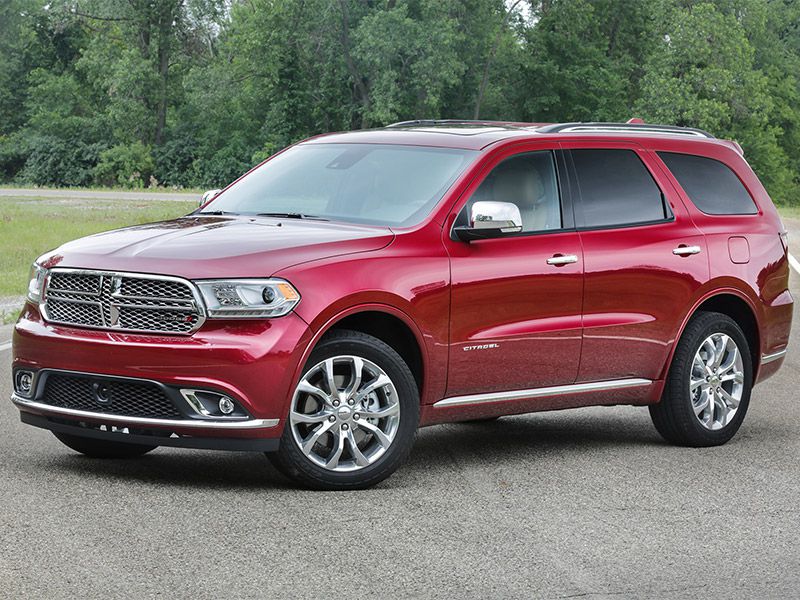
2017 Dodge Durango exterior front angle ・ Photo by Fiat Chrysler Automobiles
If you’ve got a boat to tow or a lot of kids to haul, you may be tempted by a full-size SUV like a Chevrolet Tahoe or a Ford Expedition—but what if you don’t want to drive something so big and ungainly? Dodge has a solution: The Durango, an SUV that splits the difference between gargantuan body-on-frame SUVs and more-comfortable-but-less-able crossovers.
A hidden gem
I’ve always liked the Durango, and I feel it’s an underrated SUV. Dodge hasn’t changed the current version much since its introduction in 2011, but one might argue that they don’t need to: The Durango is just fine as it is. The model I drove for this review was a mid-level GT with the new Brass Monkey appearance package. Yep, that’s what it’s called — Brass Monkey, as in the drink, the device used to support iron balls that offset the magnetic shifts around a ship’s compass, and the expression relating to low temperatures (send your young children away and Google it). A week of hard use has convinced me that the Durango, despite its questionably-tasteful name, remains a hidden gem.
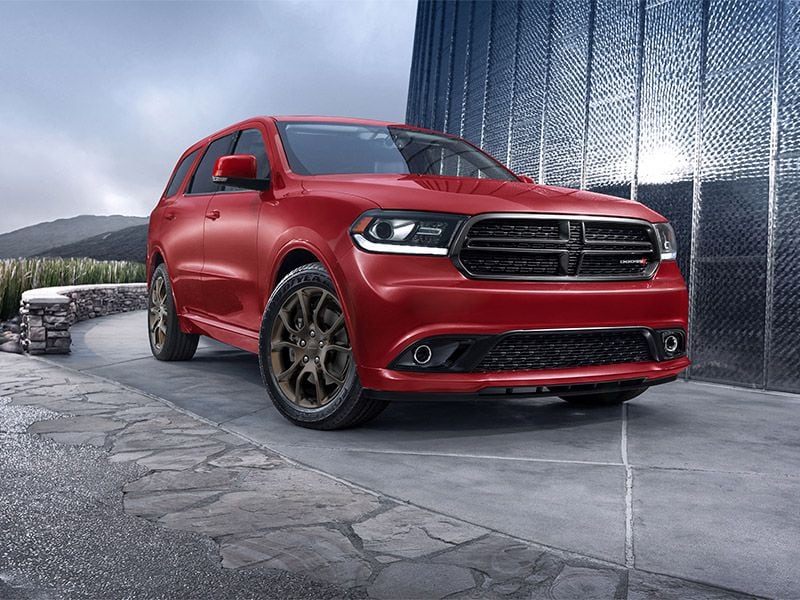
Photo by Fiat Chrysler Automobiles
Unusual size
The Durango is similar in height and width to mid-size SUVs like the Ford Explorer, Toyota 4Runner, and Jeep Grand Cherokee; in fact, it’s closely related to the Jeep, but with a longer wheelbase and more length. It’s also unusually brawny: While most SUVs in this size range are rated to tow only modest trailers, the Durango is rated to tow up to 7,200 lbs, which is more than some mid-size pickup trucks. (And yes, we put the Durango to the towing test; more on that soon.) Anyone with experience towing will tell you that length (more specifically wheelbase, the length between the front and rear axles) is critical to towing; a longer wheelbase provides more stability, so here the Durango has a clear advantage over other mid-size SUVs.
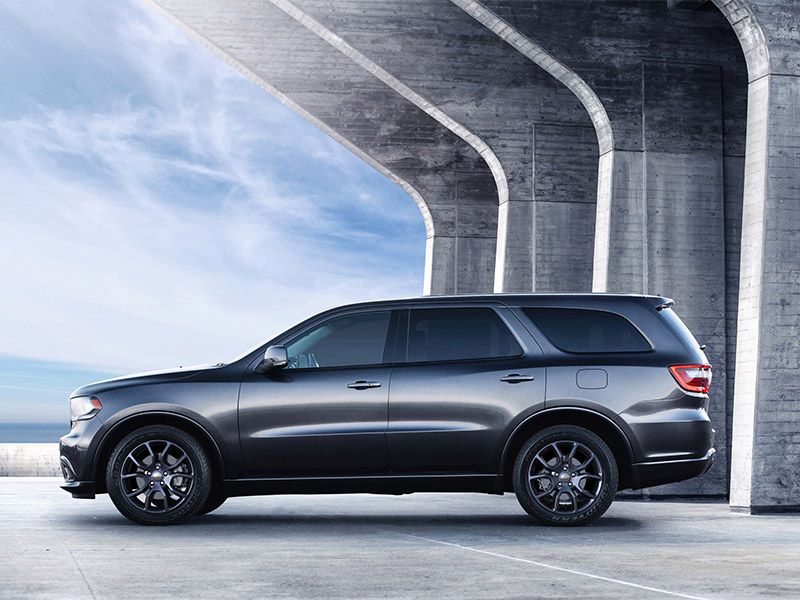
Photo by Fiat Chrysler Automobiles
Unusual looks
I’d be willing to bet that more buyers are attracted to the Durango for its looks than for its towing abilities. This is an exceptionally handsome SUV, with its aggressive crosshair grille and “racetrack” loop taillights, with subtle creases over the fenders that hint of muscles rippling underneath. And yet there is something vaguely maternal about it: Its longer length gives it more wagon-like proportions than a typical SUV. It looks like its job is to serve and protect the family (which, when you think about it, is true). The Durango I tested — a mid-level GT model — features a body-color grille with black inserts, and the Brass Monkey package (you have no idea how difficult it is to type that with a straight face) adds blacked-out badges and 20” wheels done up in bronze.
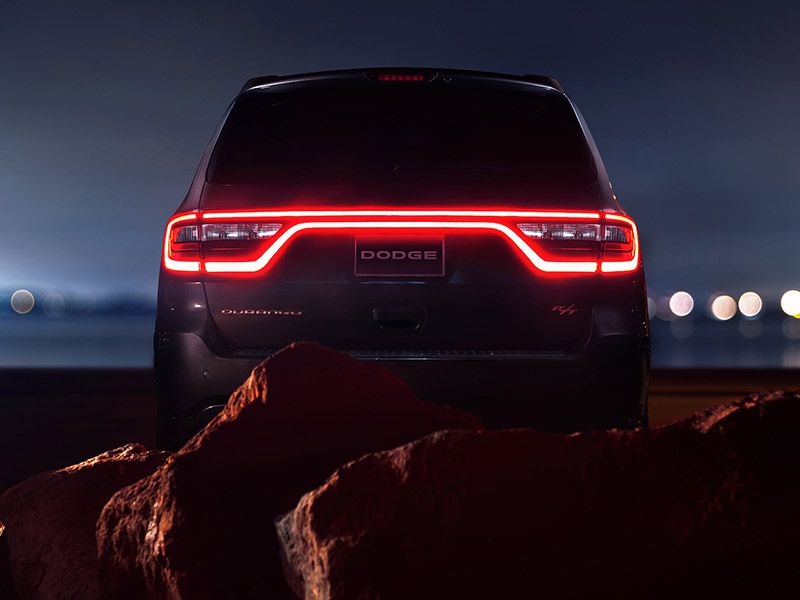
Photo by Fiat Chrysler Automobiles
A better cabin than you might expect
The Durango looks as nice on the inside as it does on the outside, something we couldn’t say about Dodge products just a few years ago. Chrysler (Dodge’s parent company) has really tightened up their game these past few years, and the Durango is a good example. The materials are high quality and the My GT featured leather seats, heated up front and in back. The gauge panel in my tester featured an analog tachometer and gauges flanking a large digital screen, which can display either a digital speedometer or a traditional dial-type. Speaking of dials, the Durango also features Chrysler’s rotary-dial shifter. It’s much easier to use than some of the other gear selectors out there, though it’s a shame Dodge plunks it down on the center console in place of a regular shifter; had they moved it to the dashboard, they could have freed up more space for odds-and-ends storage, something the Durango could use more of.
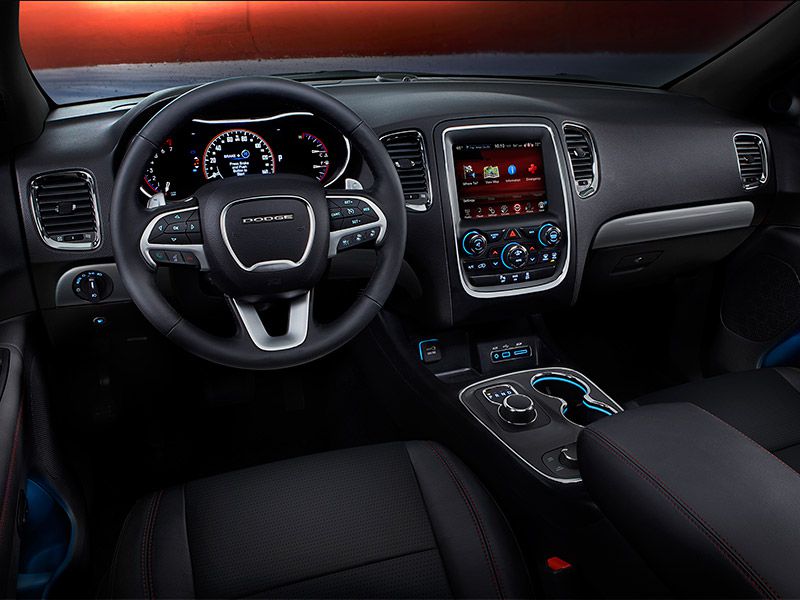
Photo by Fiat Chrysler Automobiles
Putting that space to good use
In terms of accommodations, the Durango makes good use of that extra space it offers. The front seats are very comfortable, and the second row offers plenty of room; we expect that in this segment. But the real surprise is the third row, which accommodates two adults in something at least approaching comfort; many third-row seats in competing SUVs are completely useless. And while use of the third row seats often eliminates carrying any cargo larger than a few grocery bags, the Durango still has 17.2 cubic feet available -- not enough for a family vacation, perhaps, but as much luggage space as you’d get in a compact hatchback. With the third-row seats folded down, the Durango stows a generous 47.7 cubic feet of cargo, and folding down the second row opens that up to 84.5 cubic feet. Here again, the Durango bridges the gap between traditional large crossovers and the big full-size rigs.
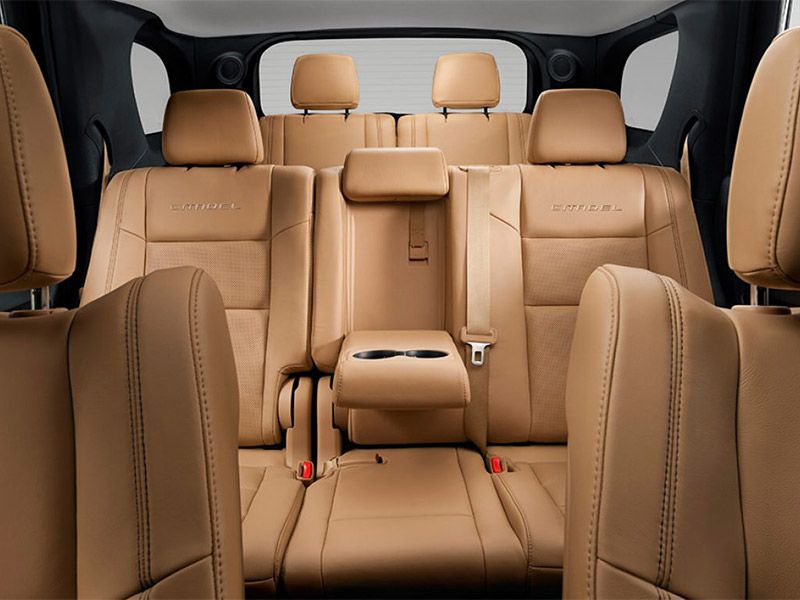
Photo by Fiat Chrysler Automobiles
Pentastar V6: Not the quickest, but it works well
The Durango I tested had Chrysler’s 3.6 liter Pentastar V6 with an eight-speed automatic and all-wheel-drive (Durangos are also offered with rear-wheel-drive). I’ve come to really like this engine: It’s smooth, quiet and powerful, though with 5,000-plus pounds of Durango to haul around, it certainly had its work cut out. This may not be the fastest SUV on the road, but even when loaded to the gills (literally) with people and luggage, it offered adequate power. EPA fuel economy estimates for the all-wheel-drive version I tested are 18 mpg city/25 mpg highway; rear-drive examples score 1 MPG lower. And the Durango did deliver: I averaged 20.4 mpg during my week long test (not counting our towing experiment; more on that in a couple of slides). The 8-speed automatic transmission can be shifted manually using paddles on the steering wheel. The Durango’s all-wheel-drive system is entirely automatic, and as with many crossover SUVs, there is no selector to change to rear-wheel drive — and I’m fine with that. Most people are looking for the best all-weather traction from an SUV, and automatic systems work best.
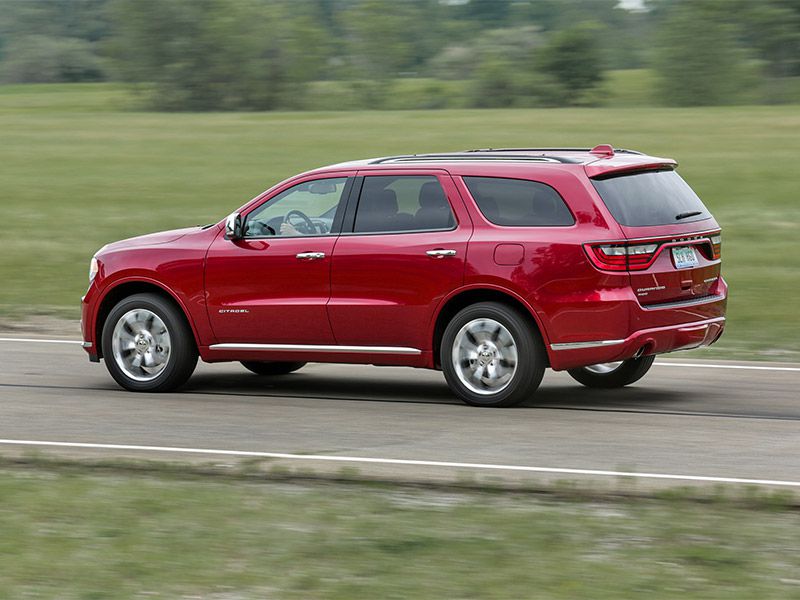
Photo by Fiat Chrysler Automobiles
A V8 for the power-hungry
For those who want more power, Dodge also offers a 5.7-liter HEMI V8, an option you won’t find in your typical mid-size crossover. This big engine puts out 360 hp and 390 lb-ft of torque, and turns the Durango into a rocket ship. As you can imagine, all that power takes its toll on fuel economy: Despite the use of the same fuel-saving 8-speed automatic transmission, the V8-powered Durango is rated at 14 MPG city and 22 MPG highway in either rear- or all-wheel-drive versions, and Dodge recommends (but does not require) mid-grade 89-octane fuel. All-wheel-drive Durangos with the V8 engine get a low mode, which provides better fuel economy, but once again there is no rear-drive mode; all-wheel-drive is always actuated automatically.
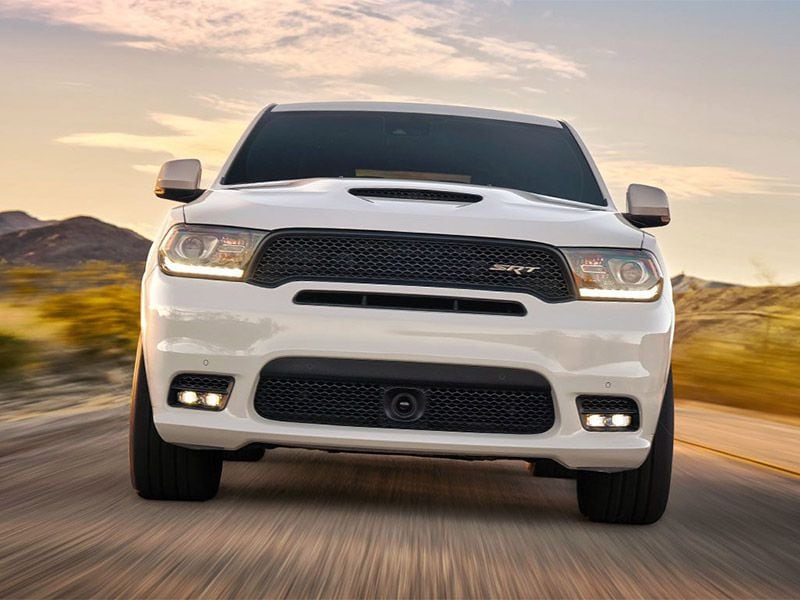
Photo by Fiat Chrysler Automobiles
Drives well despite its brawn
The problem with SUVs that can tow is that they often have other compromises: They tend to ride more roughly and handle less precisely. That’s not the case with the Durango, which is smooth, comfortable and quiet. No two-and-a-half-ton SUV is ever going to handle like a sportscar, but the Durango is respectably tidy, and certainly feels more car-like than the big SUVs. It is also a lot easier to park: While owners of Suburbans and Expeditions often have to hunt for spaces big enough (or squeeze them into regular-sized spots and ignore the fact that the people parked next to them will never be able to get their doors open), the narrower Durango fits easily into standard-sized spots, both street-side and in parking lots.

Photo by FCA Media
Set up for towing
Since trailering is one of the Durango’s strong points — and since I happen to own a trailer — I decided a little towing was in order. V6-powered Durangos like the one I was testing are rated to tow up to 6,200 lbs with a trailer towing package, putting them in the same neighborhood as mid-size pickups like the Chevrolet Colorado, Toyota Tacoma, and Honda Ridgeline. V8s can tow up to 7,200 lbs.
When towing with an SUV, one must take into consideration the GCWR—Gross Combined Weight Rating — which is the maximum permissible weight of the vehicle, trailer, and all cargo. For the Durango I am testing, it’s 11,600 lbs, and 4,987 of that is the Durango itself. So if I were to hook up a 6,200 lb trailer, I could only put 413 lbs in the cabin safely, and that includes myself, passengers, and cargo. GCWR varies by model, and Dodge lists them in the owner’s manual. Dodge offers a $995 trailer-towing package with a Class-IV hitch receiver, 4- and 7-pin wiring harness, extra engine cooling capacity, a load-leveling rear suspension, and increased GCWR. It doesn’t include a trailer brake controller, so I hooked up a Tekonsha P3 which was supplied to me by the good folks at Tekonsha. The Durango has a trailer wiring plug and Tekonsha sells a compatible wiring harness, so there was no need to do any fancy rewiring — I was able to plug the P3 directly into the Durango’s electrical system.
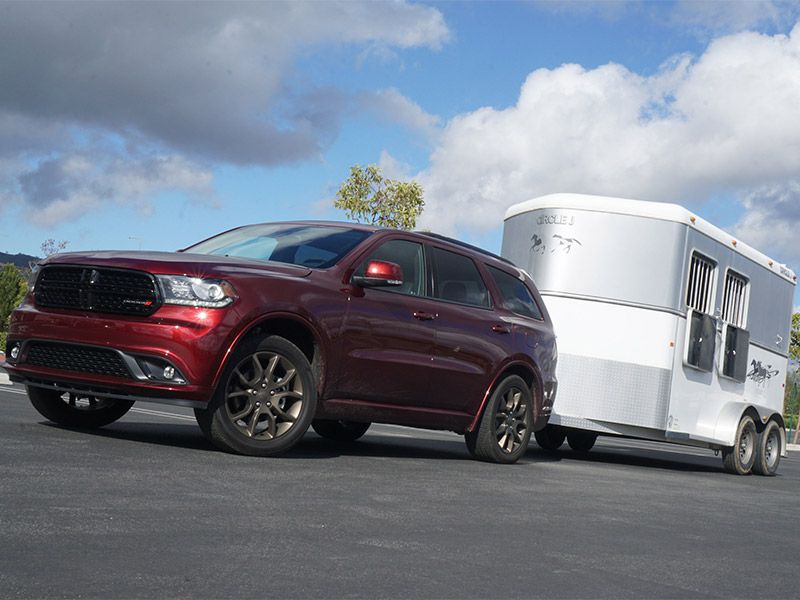
On the road with a Durango and a horse
My wife and I hooked up our horse trailer, which weighs 3,500 lbs unloaded, and hit the road. I was impressed by the Durango’s stability. It was a windy day, and while the gusts tried to blow the trailer around, the Durango stayed fairly well planted. Satisfied with the Durango’s towing abilities, we loaded up Aiden, our big draft-cross horse, bringing our trailer weight up to around 4,900 lbs. The ride stiffened considerably with the trailer weight increased, and the engine had to work quite a bit harder, but we were able to climb steep hills and accelerate to highway speeds comfortably. The brakes did heat up quite a bit; a little more fine-tuning of the trailer brake settings would help, but were we going to tow regularly, we might consider an aftermarket brake pad that could handle heat a little better. That said, it speaks volumes that we would consider towing regularly with the Durango. Robin and I are very cautious about what vehicles we use to transport our horse, and we were very impressed with the Durango’s stability. We’ve towed this same setup with several mid-size pickup trucks, and we thought the Durango did a better job than some of them. Fuel economy was good, too. We averaged 16.2 mpg during our towing tests.
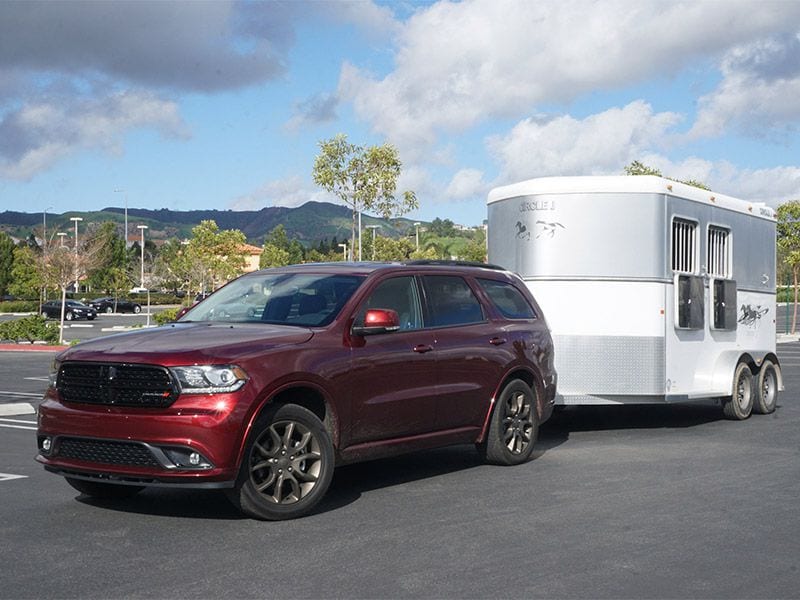
Photo by Aaron Gold